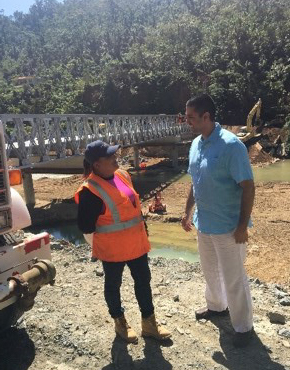
Rebuilding the bridge in rural part of Utuado.
Nearly six months have passed since Hurricanes Irma and Maria devastated Puerto Rico and the U.S. Virgin Islands. In the immediate aftermath of the storms, communications networks were virtually wiped out. More than 95% of cell sites were out in Puerto Rico and 77% of cell sites were out in the Virgin Islands. Progress is no doubt being made, with 4.4% and 13.8% of cell sites now out in Puerto Rico and the Virgin Islands, respectively. But there's still much work to do, as too many still lack connectivity and basic infrastructure.
More compelling than any statistic are the stories I heard on the ground. Earlier this month, along with members of the FCC's Hurricane Task Force, I visited Puerto Rico and the U.S. Virgin Islands. Following up on my visit to Puerto Rico last year, I wanted to get a firsthand assessment of the recovery and rebuilding efforts, and to hear from residents who shared countless examples of resiliency and inspiration.
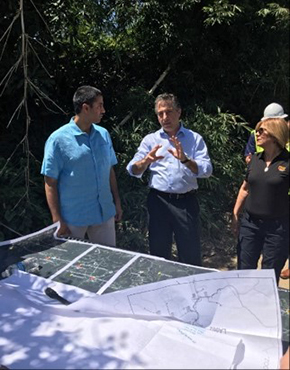
Chairman Pai met with Liberty crews working to restore service outside Utuado.
In Puerto Rico, we traveled to Utuado, a rural, interior municipio (equivalent to a county) in the west-central part of the island. It was among the places hardest-hit by Hurricane Maria. We toured the "camp of the forgotten" in the Rio Arecibo neighborhood, and met Marilyn (pictured left), who recounted her daunting experience.
During the storm, a local bridge washed away, leaving 1,600 residents stranded on the other side. The flooding was so substantial, and the water in the river so contaminated, that they had no other option but to ferry people from one side to the other. How? They put together a makeshift zipline, which included a chair that could carry one person at a time. The zipline was the community's only way to get out. To me, it brought home how brave and creative people can be in a time of need. (Marilyn, by the way, is now in charge of part of the rebuilding project. She has a tremendous spirit and is a force of nature!)

Center: utility pole snapped by Hurricane Maria. Right: Bamboo poles serve as makeshift solution to hold up communications lines. Left: newly-installed pole.
Another major problem in Puerto Rico is that the wired infrastructure has been completely destroyed. Replacing it is hard and expensive. We saw that for ourselves during a visit to a fiber restoration project in another part of west-central Puerto Rico. Just off a rough road dotted with homes, we saw one utility pole that was snapped by powerful winds. That pole used to hold the wires that gave residents telephone and Internet access. Some cable lines were lying on the ground. We saw a few others being held up by slender bamboo stalks—waiting to be transferred to replacement poles. Crews are now in the process of restringing cables and putting them back up on sturdy, new poles. The Liberty crew pictured here is mapping its work using a detailed map in the bed of a pickup. It costs more than $22,000 per mile to put the poles up and restring the fiber, but it's important work that has to be done to get service back up and running for residents.
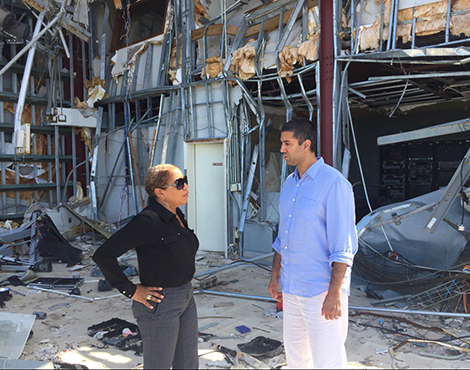
Tanya-Marie Singh, CEO of U.S. Virgin Islands public television station WTJX.
It isn't just telecom providers who were affected; broadcasters have suffered, too. In that regard, check out the picture to the left. If a picture is worth a thousand words, this one speaks a tome about the devastation in the U.S. Virgin Islands. Wires everywhere, ceiling falling down, and debris and ruined equipment all over. (See more pictures.) This was the scene at WTJX-TV. WTJX is a public television station located in St. Thomas. Chief Executive Officer Tanya-Marie Singh showed us what was once, and hopefully will again soon be, the studio of an important broadcaster on the island. She plans to rebuild the station after the current hurricane season in a way that enables WTJX to withstand future storms and keep residents informed during future emergencies. (We saw similar resolve in Puerto Rico; I met numerous radio and TV broadcasters during my time there, including an on-air appearance at WKAQ radio. Stories were common about station management and staff living in-studio for days during the storms.)
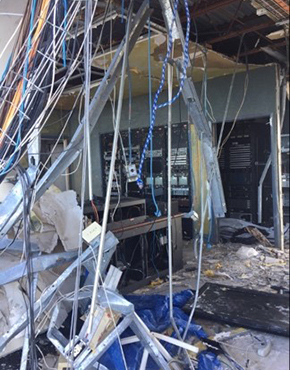
U.S. Virgin Islands public television station WTJX.
Another part of our trip was meeting with government leaders. We had the opportunity to sit down with the governors of both islands—Governor Ricardo Rosselló in Puerto Rico and Governor Kenneth Mapp in the U.S. Virgin Islands—to discuss rebuilding and restoration efforts. I briefed each of them on my proposal for the FCC to create two new funds—the Uniendo a Puerto Rico Fund (Bringing Puerto Rico Together Fund) and the Connect USVI Fund—that together would provide almost $1 billion in funding for restoring and expanding communications networks.
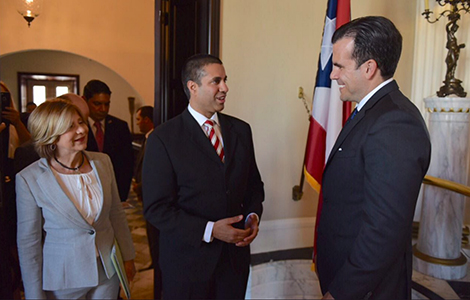
With Ricardo Rosselló, Governor of Puerto Rico.
We heard many perspectives on communications-related recovery efforts during a roundtable organized by U.S. Congresswoman Jenniffer González-Colón in San Juan; it included representatives of the Telecommunications Regulatory Board of Puerto Rico, the Puerto Rico Electric Power Authority, and the U.S. Army Corps of Engineers, among many others.
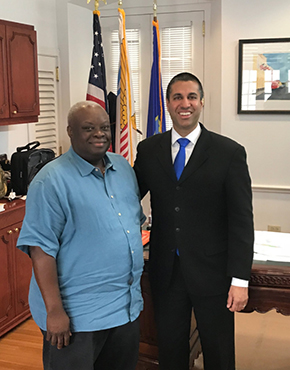
With Kenneth Mapp, Governor of the U.S. Virgin Islands.
We also participated in a very productive meeting of the Hurricane Integration Team (HIT) in the Virgin Islands. The HIT was set up to establish direct coordination among federal partners (particularly the Federal Emergency Management Agency), the private sector, and Virgin Islands officials to restore communications services. Speaking of FEMA, we sat down with FEMA staff along with the head of the Virgin Islands Territorial Emergency Management Authority to discuss where things stood. We also enjoyed getting together with the Chairman and Commissioners of the U.S. Virgin Islands Public Services Commission to discuss our shared goal of a full and prompt recovery. Finally, we visited 911 call centers in both Puerto Rico and the Virgin Islands, where we heard about some of the challenges emergency responders had fielding calls and dispatching help to residents.
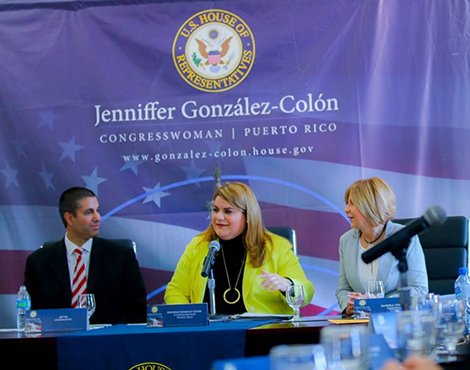
With Jenniffer González-Colón, Congresswoman for Puerto Rico.
There's much to do in Puerto Rico and the U.S. Virgin Islands to recover from last year's hurricane season, but residents are incredibly strong and resilient. We felt that spirit during the meetings described above, as well as visits to two schools, two hospitals, a police station, and more. The FCC will continue to stand side by side with them throughout the recovery and restoration process. This year's hurricane season is fast approaching (it officially starts on June 1). But especially if the FCC adopts my proposal to set up the Uniendo a Puerto Rico and Connect USVI Funds, I'm confident that our joint perseverance will prevail. I'm heartened and inspired by the people of the territories. My Hurricane Recovery Task Force colleagues and I thank them, both for hosting us and for educating us on the first-hand the effects of the devastating storms. We'll take back the lessons we learned to the FCC and do all we can to help people get back on their feet.